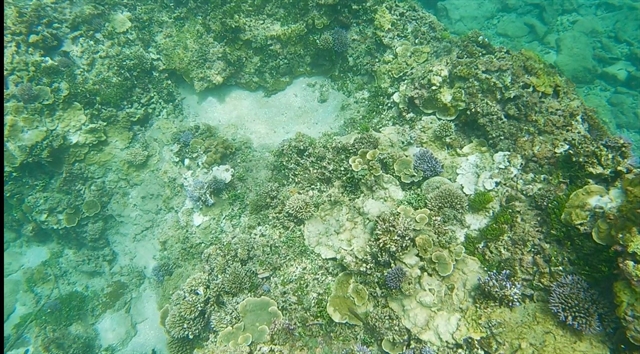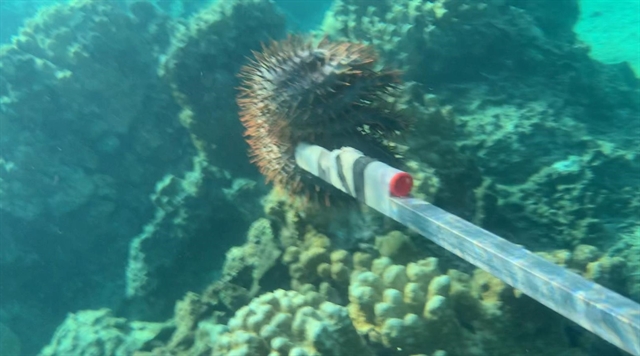 Society
Society

During a dive on a small island off the coast of Bình Thuận Province, Nguyễn Văn Giởi and other tour guides were able to see hundreds of poisonous crown-of-thorns starfish, which are coral predators.

|
| Coral is seriously damaged by crown-of-thorns starfish. — Photo provided by Nguyễn Văn Giởi |
Gia Lộc
BÌNH THUẬN — During a dive on a small island off the coast of Bình Thuận Province, Nguyễn Văn Giởi and other tour guides were able to see hundreds of poisonous crown-of-thorns starfish, which are coral predators.
“When diving to look at coral reefs on Hòn Tranh isle, we saw crown-of-thorns starfish seriously devastate the coral reefs,” said Giởi, a tour guide on Phú Quý Island in the south-central coastal province.
He and other tour guides on the larger island of Phú Quý decided to set up a team "to catch these poisonous crown-of-thorns starfish to save coral."
According to the Australian Institute of Marine Science, crown-of-thorns starfish are marine invertebrates that feed on coral and occur naturally on reefs throughout the Indo-Pacific region, and when conditions are right, they can reach plague proportions and devastate hard coral communities.
The institute’s research has revealed that crown-of-thorns starfish are a major cause of coral loss on the Great Barrier Reef.
These starfish can grow to over 50 centimetres in diametre, and one individual can consume over 13 square metres of coral reef per year, according to the New Heaven Reef Conservation Programme’s team in Thailand.
When Giởi and other members of the team have free time, they go to Hòn Tranh isle to catch crown-of-thorns starfish.
“In one day, we can catch nearly 500-700 starfish. We often catch them in summer because the water is warm for diving,” Giởi said.
.jpg)
|
| A member of a tour guide team catches crown-of-thorns starfish. Photo provided by Nguyễn Văn Giởi |
Compared to the past, more and more crown-of-thorns starfish are appearing because of an imbalance in the marine ecosystem, he said, adding that starfish predators such as giant triton snail and sea urchins are overfished on the island to serve tourism.
Sea urchins play a critical role in maintaining the balance between coral and algae.
Nguyễn Trọng Tấn, another member of the team, said: “Diving to see coral reefs on Hòn Tranh isle appeals to tourists. So when coral is lost by crown-of-thorns starfish, tourists will no longer like to come to the island. His job as a tour guide also will be affected.”
Tấn has called on other tour guides to join his team to catch crown-of-thorns starfish when they have free time.

|
| Crown-of-thorns starfish are coral predators. Photo provided by Nguyễn Văn Giởi |
Crown-of-thorns starfish are very poisonous and dangerous for divers, he said. When their spines accidentally hit a diver, it causes swelling and severe inflammation which could be life-threatening.
Giởi said: “We're very careful when catching starfish. We are working for sustainable tourism development on the island.”
The Bình Thuận Province’s Fisheries Division estimates that each 100 square metres contains 50-60 crown-of-thorns starfish.
Bình Thuận Province has two marine reserves in Cù Lao Câu and Phú Quý islands.
Phú Quý Island is surrounded by a thick ring of coral reefs. Its deepest point is 42 metres. The island has 72 species of seaweed, 134 species of stony coral and 15 species of mollusks.
According to the Fisheries Division, 10 years ago, the sea surrounding the island was recognised as having the most beautiful coral reefs in the country. However, over the last several years, coral reefs have been devastated or lost.
That is why the province set up the marine reserve on the island.
The division has been working with the island's People’s Committee to carry out a crown-of-thorns starfish monitor programme. Their staff dive to catch and find them.
It has also asked for help from the Directorate of Fisheries and Institute of Oceanography in Khánh Hòa Province’s Nha Trang city to provide the optimal methods to kill them. — VNS
Bình Thuận Province People’s Committee last June recognised Phú Quý Island as a provincial level tourism site. This is expected to help the island attract more investors. Island authorities are developing tourism products associated with the sea. Green and sustainable tourism also is being promoted. Last year it attracted 42,000 tourists, up from 7,000 in 2016. Its revenue last year reached more than VNĐ100 billion (US$4.3 million). It targets 65,000 tourists, including 4,500 foreign tourists, by 2025. — VNS |